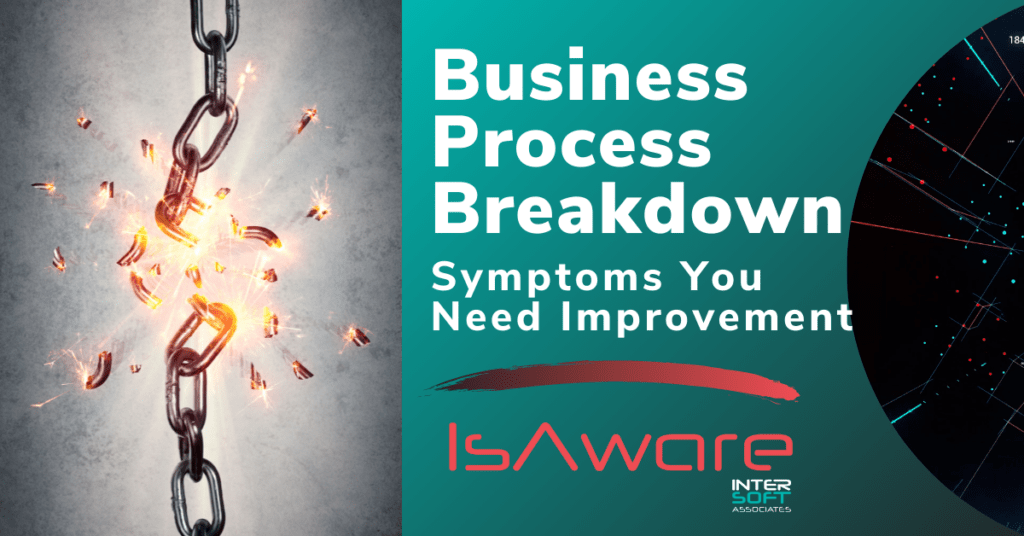Business processes are the coordinated systems and practices that help your business operate effectively, and help your employees and business partners understand how their roles are related to the roles of others. What happens when those processes aren’t working properly? How would you even know? Read on to explore symptoms of business process breakdowns and why a culture of problem-solving is crucial to running an efficient, profitable organization.
The Broken Business Process
How do you know if your business processes are broken? The nature of this problem is that those suffering most from the broken processes have often found inefficient workarounds or repairs that mask issues just so they can get their task completed. In order to recognize them before it’s too late It is helpful to look at some common symptoms of broken business processes.
You have a bunch of systems but aren’t getting valid data, or getting data is taking too long
If you are looking for important and strategically necessary information and it’s taking a long time to retrieve it, or if you have to have several people, departments, or systems communicating to get information, you more than likely have a serious problem. Sometimes different departments will have duplicate (or almost duplicate) versions of similar data and there’s no single “source of the truth.” This will show itself in inconsistent information – for example, why is sales data or backorders different in different databases? Which A/R balance is correct? The right data management will mean everybody has easy access to the same data.
Departments (Or People) Are Silo’d
Back to the idea of there being no single source of truth, sometimes departments are not aware of what other departments are doing. You don’t know if or how the data one department is accessing or using compares to another department’s data, and…you don’t really care – clearly you should! People are just trying to get their work done sometimes without regard to the rest of the organization and its needs, and they’re doing it with what they have available to them. In this case your symptom might not be something the data itself is showing so much as the culture that the employees of the company are demonstrating: If you have many departments operating autonomously of each other, you can bet that there are broken processes slowing people down and they might not even know it. More importantly, it can be costing you millions of dollars in sales or unnecessary expenses.
You Have Some Old (And Maybe Bad) Habits
If you are using old technology or legacy software applications to accomplish tasks or manage information, you might be operating with a great deal of inefficiency without even knowing it. Imagine a scenario in real estate, for example, where an organization has a tried-and-true system of emailing clients or customers with a link to a PDF that then needs to be filled out and returned. On the client’s side, the form needs to be downloaded. Some people might print it out, fill it out by hand, rescan the document and then send it back. Others might fill out the form digitally, save the document, then return it. In both cases there is a rich opportunity for human error, the process is slow and cumbersome and transactions (and revenue and profits) can be slowed down. And – once upon a time – this was how many companies conducted business. A more modern alternative is using something like Docusign, where with a few clicks or taps the client can almost immediately do what is necessary to finish a task and the process can move along. Staying handcuffed to old, outdated technology and processes can slow your company down and create a less desirable customer experience.
You Are Confusing the Means for The End
Is your CRM powerful enough? Is there an API available to share this data with that platform? Can you access this kind of report from that kind of software? If these are the kinds of questions you are starting with, you might already be setting yourself up for frustration. The how – the technology questions – are relevant and important, but they have to come after the why questions. Why are your people frustrated and why are critical processes going slowly? Why is so much time being spent on this task? What would be ideal in this situation? In short, what are the pains being experienced? A capable custom software consultant will listen and help develop a strategy for improved business processes that might involve any number of technical and operational approaches – but those are only considered to resolve the why. If you fail to recognize this you could spend a great deal of time (and money) building or refining archaic processes that are never going to solve the core problem, or that can’t by themselves solve the problems.
Your Culture Needs Work
The people that do the work in your organization know where the problems are. Unfortunately, leaders can often be insulated from day-to-day process friction. They often underestimate the impact broken processes and inefficiency can have on the bottom line, top line, and even morale and productivity. If you don’t know how stuff gets done in your company then you are going to have a hard time identifying the problems and solutions. A culture of trust, communication, innovation and efficiency can help everybody in an organization see themselves as crucial parts of healthy business processes.
Better Business Processes Builds Better Business
How things get done in a company is, ultimately, what the customer is buying. Dysfunction and inefficiency almost always has a way of showing itself to the customer experience through mistakes in accounting, slow shipping, inaccurate product fulfillment, long wait, delivery, or service times, and on and on. Better business processes that are fine-tuned to creating sustainable success helps every aspect of how you do business.
Remember, you don’t need to know what your problem is to know you have a problem. If some of these symptoms are familiar, it’s time to give us a call. Together we’ll help you identify problem areas, envision ideal outcomes, and build the processes to achieve success.






